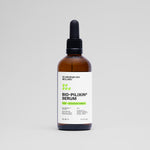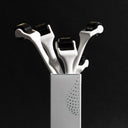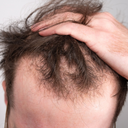Hair growth treatments are more popular than ever, but are they safe? With so many options—from medications to natural remedies to transplants—it’s easy to feel overwhelmed.
The truth is, not every treatment works the same for everyone, and some come with risks. Understanding hair growth treatment safety is key to getting results without unwanted surprises.
Whether you're considering minoxidil, finasteride, PRP therapy, or supplements, knowing the possible side effects and how to use them properly can save you a lot of trouble.
Table of content
What are the most popular hair growth treatments?
There’s no one-size-fits-all approach to hair growth. Some treatments focus on stimulating follicles, while others aim to slow down hair loss. Some require a prescription, while others can be picked up at your local pharmacy. But how do they actually work? And are they safe? Let’s break down the most well-known options, their effectiveness, and what you should watch out for.
1. Minoxidil

Minoxidil is one of the most widely used hair growth treatments. Available as a foam or liquid, it’s applied directly to the scalp to stimulate hair follicles and encourage regrowth. It’s often recommended for both men and women experiencing pattern baldness.
It works by improving blood flow to the scalp, which keeps hair in the growth phase longer. But patience is key—it can take three to six months to see noticeable results.
The catch? Some people experience initial shedding, scalp irritation, or unwanted hair growth in areas where the product drips.
The good news is that minoxidil is FDA-approved and generally safe, but stopping treatment can reverse any progress. If you’re thinking about trying it, consistency is your best friend.
2. Finasteride
Finasteride is an oral medication designed to slow down hair loss rather than directly regrow hair. It works by blocking dihydrotestosterone (DHT), the hormone responsible for shrinking hair follicles in male pattern baldness.
Unlike minoxidil, which is applied topically, finasteride is taken as a pill once a day.
It’s a solid option for many men, with studies showing that over 80% of users experience reduced hair loss. Some even see noticeable regrowth after a year of use.
However, finasteride does come with potential side effects, including decreased libido, mood changes, and, in rare cases, persistent sexual dysfunction.
It’s generally not recommended for women, especially those who are pregnant or trying to conceive, as it can affect fetal development. If you’re considering finasteride, it’s worth having a conversation with a healthcare provider to weigh the pros and cons.
3. PRP therapy
Platelet-rich plasma (PRP) therapy is a medical procedure that uses your own blood to stimulate hair growth. It involves drawing a small amount of blood, processing it to concentrate the platelets, and then injecting it into thinning areas of the scalp.
These platelets contain growth factors that help repair and regenerate hair follicles.
PRP has gained popularity because it’s a natural option with minimal downtime. Many people see an improvement in hair thickness after a few sessions.
However, it’s not a guaranteed fix. Some respond better than others, and results can take a few months to show.
The biggest downside? PRP therapy is expensive and requires multiple treatments. Plus, while the procedure itself is generally safe, some people experience mild discomfort, swelling, or bruising at the injection sites.
If you’re looking for a non-drug option, PRP might be worth exploring, but it’s not a magic bullet.
4. Red light therapy
Red light therapy (also called low-level laser therapy or LLLT) is a non-invasive treatment that uses light energy to stimulate hair follicles. It’s typically delivered through laser caps, helmets, or in-office treatments.
The science behind it? Red light is believed to boost circulation in the scalp, providing follicles with more oxygen and nutrients.
Some studies suggest it helps prolong the hair growth phase, making it a promising option for those with mild to moderate hair thinning.
There are no major side effects, making it one of the safest hair growth treatments available. However, it requires regular use—most devices need to be worn several times a week for 15–30 minutes.
Results vary, and while some people notice thicker hair, others may see little to no improvement.
5. Scalp micropigmentation
Scalp micropigmentation (SMP) isn’t technically a hair growth treatment, but it’s an effective cosmetic solution for hair loss. Think of it as a hair tattoo—tiny dots of pigment are applied to the scalp to create the illusion of a shaved head or denser hair in thinning areas.
It’s a great option for those who don’t want to commit to medications or surgeries. There’s no downtime, and results can last for several years before a touch-up is needed.
The downside? SMP doesn’t actually regrow hair—it just gives the appearance of fuller hair. Plus, it requires an experienced technician to achieve a natural look. If done incorrectly, the results can look unnatural, and removing it is difficult.
6. Hair transplant

For those looking for permanent results, a hair transplant is often the go-to solution. This surgical procedure involves taking healthy hair follicles from one part of the scalp (usually the back) and transplanting them to thinning or bald areas.
There are two main methods:
- FUE (Follicular Unit Extraction): Individual follicles are extracted and implanted one by one.
- FUT (Follicular Unit Transplantation): A strip of scalp is removed, and hair follicles are harvested from it.
Hair transplants deliver long-lasting results, but they come with a hefty price tag and require downtime for recovery. Swelling, scarring, and temporary shedding (shock loss) are possible side effects.
While transplants work well for many, they’re not suitable for everyone. People with diffuse thinning or ongoing hair loss may not get the best results.
7. Natural remedies
Some people prefer to keep things simple and natural. Popular home remedies include:
- Rosemary oil: Shown in studies to work as well as minoxidil.
- Aloe vera: Soothes the scalp and may help reduce inflammation.
- Scalp massage: Increases blood flow to hair follicles.
Natural options tend to work slower, and while they may support hair health, they’re not always enough to stop hair loss entirely. That said, they’re safe for most people and can be a good addition to a broader treatment plan.
8. Supplements
Hair growth supplements are everywhere, but do they work? The answer depends on what’s causing your hair loss. If a deficiency is to blame, supplements like biotin, iron, zinc, or collagen can help.
However, taking too much of certain vitamins can do more harm than good. For example, excess iron can be dangerous, and high doses of biotin can interfere with lab tests.
A balanced diet is the best way to get essential nutrients, but if you suspect you’re lacking something, getting bloodwork done before taking supplements is a smart move.
As your leading source for hair health information over the past 4 years, we never compromise on accuracy. When it comes to your health, you deserve information you can truly rely on - and earning your trust is our top priority.
Here's how Scandinavian Biolabs ensures every piece of content meets the highest standards of accuracy and integrity:
- Credentialed Experts: Our reviewers are actively practicing doctors and medical researchers
- Stringent Reviews: Content undergoes rigorous editing by subject specialists and review by a practicing doctor.
- Evidence-Based: We rely on well-established research from trusted scientific sources like peer-reviewed journals and health authorities.
- Full Transparency: Our editorial standards, writer credentials, reviewer credentials, correction process, and funding are all publicly documented.
- Independent Voice: While we do promote products, we operate in a vacuum to business operations. Our main goal is just an unwavering commitment to providing medically-sound guidance.
You can count on Scandinavian Biolabs to consistently deliver the trustworthy health information you deserve. Read our Editorial Standards.
How to choose the safest hair growth treatment
Here's how to choose a safe and effective hair growth treatment without unnecessary risks:
- Identify the cause of hair loss—not all treatments work for every type of hair loss.
- Check for FDA approval and clinical backing—medications like minoxidil and finasteride have been studied for safety and effectiveness.
- Consider potential side effects—some treatments come with risks like irritation, hormonal changes, or allergic reactions.
- Think about long-term commitment—many treatments require ongoing use for lasting results.
- Assess your health condition—certain medications and procedures aren’t safe for everyone.
- Consult a medical professional—getting expert advice can help you avoid costly mistakes.
Identify the cause of hair loss
Before picking a treatment, it’s important to know what’s causing your hair loss. Not all hair loss is the same—some cases are due to genetics, while others stem from stress, hormonal imbalances, or medical conditions.
- Genetic hair loss (androgenetic alopecia) responds well to minoxidil and finasteride.
- Temporary shedding (telogen effluvium) may resolve with lifestyle changes and proper nutrition.
- Autoimmune-related hair loss (alopecia areata) may require corticosteroids or immunotherapy.
Choosing the right treatment starts with understanding the root cause. If you're unsure, a dermatologist can help you figure it out.
Check for FDA approval and clinical backing
Not all hair growth treatments are backed by science. Some are hyped up with big claims but have little research behind them. If you're considering a treatment, look for:
- FDA approval—medications like minoxidil and finasteride have been studied for safety.
- Clinical trials—procedures like PRP therapy have promising studies, but results vary.
- A history of success—natural remedies like rosemary oil have research showing they can help.
A treatment that sounds too good to be true probably is. If there's no scientific support behind it, proceed with caution.
Consider potential side effects
Every treatment comes with some level of risk. The key is knowing what to expect and what’s not normal.
- Minoxidil can cause dryness, itching, and an initial shedding phase.
- Finasteride may lead to hormonal side effects, including reduced libido.
- PRP therapy can result in mild discomfort or swelling at the injection site.
Understanding side effects before you start treatment can help you decide if it’s worth it. If something doesn’t feel right, always check with a professional.
Think about long-term commitment
Some hair growth treatments only work as long as you keep using them. For example:
- Minoxidil needs to be applied consistently—stopping can lead to hair loss returning.
- Finasteride must be taken daily to maintain results.
- Hair transplants are permanent but require months of patience to see final results.
If you’re not willing to commit to a long-term plan, you might need to rethink your approach.
Assess your health condition
Certain medications and procedures aren’t safe for everyone. If you have:
- Heart conditions or low blood pressure—minoxidil may not be a good choice.
- Hormonal imbalances—finasteride could have unwanted effects.
- Autoimmune diseases—PRP therapy may not work as well.
Your health history plays a big role in choosing the safest treatment. Always check for potential interactions with any medications you're already taking.
Consult a medical professional
Before starting any treatment, talk to a doctor or dermatologist. They can:
- Diagnose the cause of your hair loss
- Recommend treatments that suit your condition
- Help you avoid unnecessary risks
Skipping this step could lead to wasted time, money, and frustration. A little expert advice upfront can save you from a bad experience later.
Side effects of hair growth treatments
While hair growth treatments can be effective, some come with side effects. The good news? Most are mild and temporary. The key is knowing what’s normal and when to be concerned.
Minoxidil side effects
Minoxidil is well-tolerated by most people, but it can cause:
- Scalp irritation—some experience redness, itching, or flaking.
- Shedding phase—this happens in the first few weeks but is usually temporary.
- Unwanted hair growth—if it drips onto the face, fine hairs can appear.
Most of these side effects are mild and go away over time. If irritation is severe, switching to a lower concentration or a foam formula may help.
Finasteride side effects
Finasteride is effective, but it can cause:
- Hormonal changes—some men experience a drop in libido.
- Mood changes—a small percentage report anxiety or depression.
- Potential long-term effects—rare cases of persistent sexual dysfunction have been reported.
Not everyone experiences side effects, but it’s worth considering before committing to daily use.
PRP therapy side effects
Since PRP uses your own blood, it’s generally safe. However, some people may notice:
- Mild swelling and bruising
- Temporary discomfort at injection sites
- Rare risk of infection
The procedure is low-risk, but results vary from person to person.
Hair transplant side effects
Hair transplants are surgical procedures, so side effects can include:
- Swelling and redness in the first few days
- Shock loss, where transplanted hair temporarily falls out
- Scarring, depending on the method used
Recovery takes time, but most people see good results within a year.
Who should avoid certain hair growth treatments?

Not every treatment is suitable for everyone. Some medical conditions, medications, or life circumstances make certain treatments a bad idea. If any of the following apply, it’s best to look for alternatives.
- Pregnant or breastfeeding women—finasteride is not safe, and minoxidil should be used with caution.
- People with heart conditions or low blood pressure—minoxidil can lower blood pressure further.
- Anyone with a history of hormonal imbalances—finasteride may not be ideal.
- Individuals with sensitive skin or allergies—some topical treatments can cause irritation.
- People with autoimmune disorders—PRP therapy may not be effective.
- Those unwilling to commit long-term—some treatments must be used continuously for results.
If you fall into any of these categories, it’s worth exploring alternative options like laser therapy, scalp micropigmentation, or hair-friendly nutrition.
How to minimize risks & maximize hair growth safely
While hair growth treatments can be effective, how you use them matters just as much as the treatment itself. A few smart choices can make all the difference in avoiding side effects and getting the best possible results.
- Start with a patch test – If you’re trying a new topical treatment, apply a small amount on your skin first. This helps check for allergies or irritation before using it on your scalp.
- Use the right dosage – More isn’t always better. Whether it’s minoxidil, supplements, or a prescription medication, stick to recommended amounts. Overuse can lead to unwanted side effects.
- Be patient and consistent – Hair regrowth doesn’t happen overnight. Many treatments take three to six months to show noticeable improvement, so don’t quit too soon.
- Keep your scalp healthy – A clean, well-nourished scalp provides the best environment for hair to grow. Look for gentle shampoos, avoid harsh chemicals, and keep up with regular scalp massages.
- Monitor side effects – If you notice irritation, increased shedding, or any unusual symptoms, adjust your routine or speak with a professional. Sometimes, switching to a milder formula or changing how often you apply a product can help.
- Combine treatments wisely – Some treatments work better together, like minoxidil and microneedling or PRP and finasteride. Just make sure they’re safe to use together and won’t irritate your scalp.
Small adjustments can go a long way in making hair growth treatments more effective and comfortable.
A better alternative for your overall hair health

If you're looking for a safe, drug-free approach to hair regrowth, Bio-Pilixin Activation Serum is an option worth considering.
Unlike traditional treatments that rely on synthetic drugs, this serum is formulated with plant-based growth factors developed through stem cell technology.
What makes it stand out? It’s been clinically tested, showing promising results for both men and women dealing with different types of hair loss. In a study of 30 participants:
- 77% reported reduced hair loss within 45 days
- 93% had a clinically tested reduction in hair loss after 150 days
- 73% had a measurable increase in hair density
One of the first things users notice? Less hair in the shower, often within just a few weeks. That’s a small but reassuring sign that something is working.
The formula is designed with effective, third-party tested ingredients, all of which are 100% vegan. Key ingredients include:
- Capilia Longa® – A natural compound that has shown up to an 89% reduction in hair loss and a 52% improvement in hair density in studies.
- Niacinamide – Helps strengthen hair by stimulating keratin production, a key protein that makes up most of your hair structure.
- Vanillyl Butyl Ether – A mild warming agent that increases blood flow to the scalp, improving nutrient and oxygen delivery to the hair follicles.
For those who want a gentle but effective approach to hair regrowth, Bio-Pilixin offers a science-backed, daily-use formula—no prescriptions needed.
And with a 150-day money-back guarantee, it’s a low-risk option for anyone looking to support their hair naturally.
When to stop or switch treatments
If a hair growth treatment isn’t working or is causing unwanted side effects, it may be time to stop or switch to a different approach. The key signs? Persistent irritation, worsening hair loss, or no visible improvement after several months.
Some treatments, like minoxidil, come with an initial shedding phase, which is normal. But if excessive shedding continues for more than a couple of months, it’s worth re-evaluating.
Similarly, medications like finasteride may cause hormonal changes that don’t sit well with everyone. If side effects interfere with your daily life, stopping may be the best choice.
It’s also important to know when patience is needed versus when a change is necessary. Many treatments take months to show results, so switching too soon can be a mistake.
If you’re unsure, consulting a professional can help guide your decision.
Conclusion
Choosing a hair growth treatment isn’t just about what works—it’s about what works safely for you. Whether you go for medications like minoxidil and finasteride, procedures like PRP therapy, or a natural alternative like Bio-Pilixin, understanding the risks, benefits, and timelines is key.
Some treatments require long-term commitment, while others need careful monitoring for side effects. The best approach?
A mix of patience, consistency, and expert guidance. If a treatment isn’t delivering results or causes discomfort, there are always alternatives.
Healthy hair starts with the right choices, not just the right products.
References:






